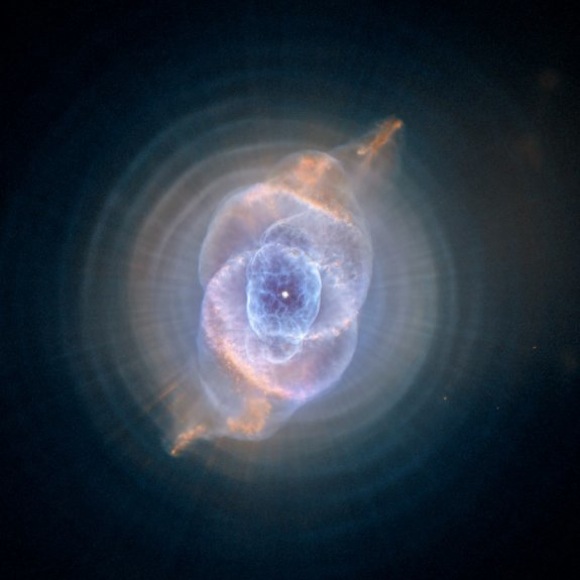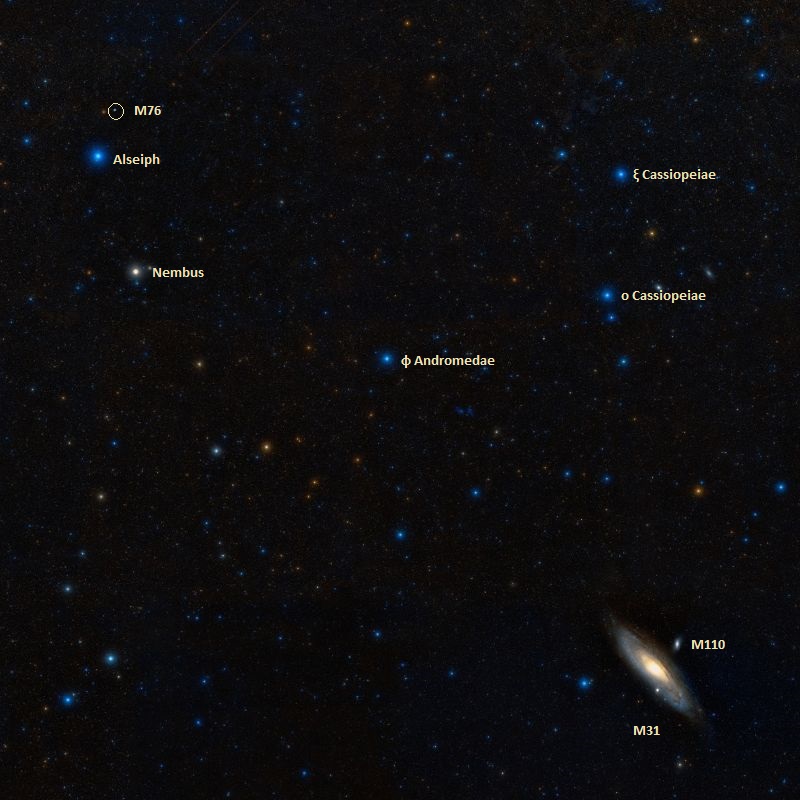A planetary nebula is one of the most beautiful objects in the universe. Formed from the decaying remnants of a mid-sized star like a sun, no two are alike. Cosmically ephemeral, they last for only about 10,000 years – a blink of a cosmic eye. And yet they are vitally important, as their processed elements spread and intermingle with the interstellar medium in preparation for forming a new generation of stars. So studying them is important for understanding stellar evolution. But unlike their stellar brethren, since no two are alike, it’s hard to efficiently pick them out of astronomical deep-sky surveys. Thankfully, a research team has recently developed a method for doing just that, and their work could open up the door to fully understanding the great circle of stellar life.
Continue reading “Can You Spot a Planetary Nebula from a Few Blurry Pixels? Astronomers Can – Here’s How”Messier 76 – the NGC 650/651 Planetary Nebula
Welcome back to Messier Monday! Today, we continue in our tribute to our dear friend, Tammy Plotner, by looking at the “little dumbbell” itself, the planetary nebula known as Messier 76!
During the 18th century, famed French astronomer Charles Messier noticed the presence of several “nebulous objects” while surveying the night sky. Originally mistaking these objects for comets, he began to catalog them so that others would not make the same mistake. Today, the resulting list (known as the Messier Catalog) includes over 100 objects and is one of the most influential catalogs of Deep Space Objects.
One of these objects is the Messier 76 (aka. the Little Dumbbell Nebula, the Barbell Nebula, or the Cork Nebula) a planetary nebula located about 2,500 light years away in the Perseus Constellation. While it is easy to find because of its proximity to the Cassiopeia Constellation (located just south of it), the faintness of this nebula makes it one of the more difficult Messier Objects to observe. Continue reading “Messier 76 – the NGC 650/651 Planetary Nebula”
Binary Stars Orbiting Each Other INSIDE a Planetary Nebula
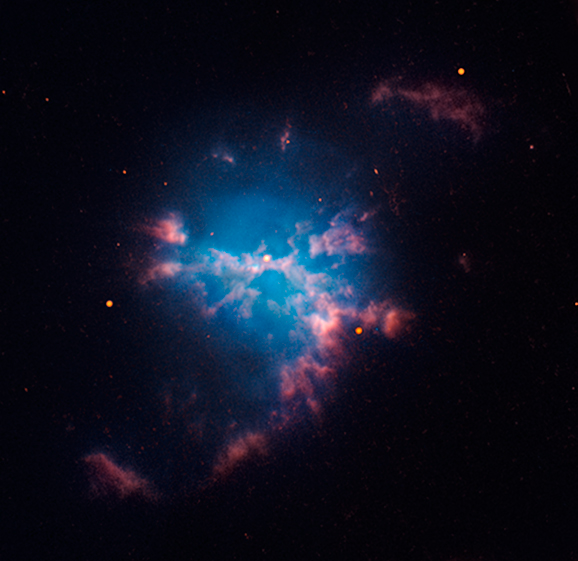
Planetary nebulae are a fascinating astronomical phenomena, even if the name is a bit misleading. Rather than being associated with planets, these glowing shells of gas and dust are formed when stars enter the final phases of their lifespan and throw off their outer layers. In many cases, this process and the subsequent structure of the nebula is the result of the star interacting with a nearby companion star.
Recently, while examining the planetary nebula M3-1, an international team of astronomers noted something rather interesting. After observing the nebula’s central star, which is actually a binary system, they noticed that the pair had an incredibly short orbital period – i.e. the stars orbit each other once every 3 hours and 5 minutes. Based on this behavior, the pair are likely to merge and trigger a nova explosion.
Continue reading “Binary Stars Orbiting Each Other INSIDE a Planetary Nebula”
The Future of Our Sun is Still a Bit of a Puzzle. What Will Happen When it Dies?
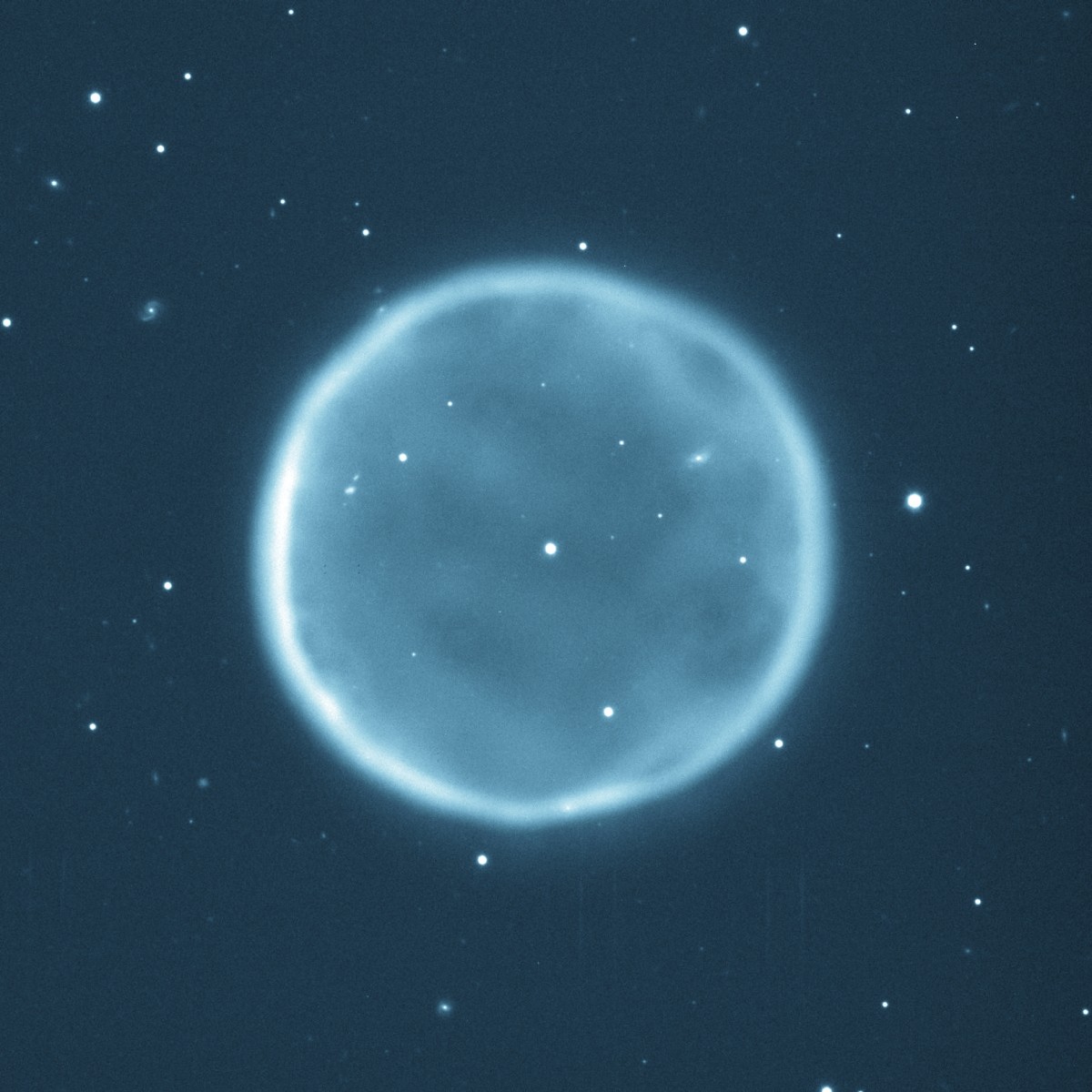
The life cycle of our Sun began roughly 4.6 billion years ago. In roughly 4.5 to 5.5 billion years, when it depletes its supply of hydrogen and helium, it will enter into its Red Giant Branch (RGB) phase, where it will expand to several times its current size and maybe even consume Earth! And then, when it has reached the end of its life-cycle, it is believed that it will blow off its outer layers and become a white dwarf.
Until recently, astronomers were not certain how this would take place and whether or not our Sun would end up as a planetary nebula (as most other stars in our Universe do). But thanks to a new study by an international team of astronomers, it is now understood that our Sun will end its life-cycle by turning into a massive ring of luminous interstellar gas and dust – known as a planetary nebula.
Their study, titled “The mysterious age invariance of the cut-off the Planetary Nebula Luminosity Function“, was recently published in the scientific journal Nature. The study was led by Krzysztof Gesicki, an astrophysicist from Nicolaus Copernicus University, Poland; and included Albert Zijlstra and M Miller Bertolami – a professor from the University of Manchester and an astronomer the Instituto de Astrofísica de La Plata (IALP), Argentina, respectively.
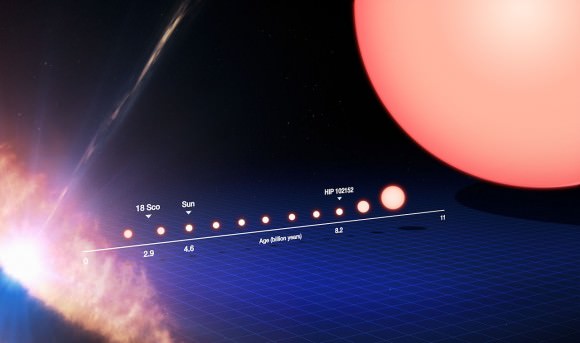
Roughly 90% of all stars end up as a planetary nebula, which traces the transition they go through between being a red giant and a white dwarf. However, scientists were previously unsure if our Sun would follow this same path, as it was thought to not be massive enough to create a visible planetary nebula. To determine if this would be the case, the team developed a new stellar, data-model that predicts the lifecycle of stars.
This model – which they refer to as the Planetary Nebula Luminosity Function (PNLF) -was used to predict the brightness of the ejected envelope for stars of different masses and ages. What they found was that our Sun was just massive enough to end up as a faint nebula. As Prof. Zijlstra explained in a Manchester University press release:
“When a star dies it ejects a mass of gas and dust – known as its envelope – into space. The envelope can be as much as half the star’s mass. This reveals the star’s core, which by this point in the star’s life is running out of fuel, eventually turning off and before finally dying. It is only then the hot core makes the ejected envelope shine brightly for around 10,000 years – a brief period in astronomy. This is what makes the planetary nebula visible. Some are so bright that they can be seen from extremely large distances measuring tens of millions of light years, where the star itself would have been much too faint to see.”
This model also addressed an enduring mystery in astronomy, which is why the brightest nebulae in distant galaxies all appear to have the same luminosity. Roughly 25 years ago, astronomers began to observe this, and found that they could gauge the distance to other galaxies (in theory) by examining their brightest planetary nebulae. However, the model created by Gesicki and his colleagues contradicted this theory.

In short, the luminosity of a planetary nebula does not come down to the mass of the star creating it, as was previously assumed. “Old, low mass stars should make much fainter planetary nebulae than young, more massive stars,” said Prof. Zijlstra. “This has become a source of conflict for the past for 25 years. The data said you could get bright planetary nebulae from low mass stars like the Sun, the models said that was not possible, anything less than about twice the mass of the sun would give a planetary nebula too faint to see.”
Essentially, the new models demonstrated that after a star ejects its envelope, it will heat up three times faster than what older models indicated – which makes it much easier for low mass stars to form a bright planetary nebula. The new models also indicated that the Sun is almost exactly at the lower cut off for low mass stars that will still produce a visible, though faint, planetary nebula. Anything smaller, Prof. Zijlstra added, will not produce a nebula:
“We found that stars with mass less than 1.1 times the mass of the sun produce fainter nebula, and stars more massive than 3 solar masses brighter nebulae, but for the rest the predicted brightness is very close to what had been observed. Problem solved, after 25 years!”
In the end, this study and the model the team produced has some truly beneficial implications for astronomers. Not only have they indicated with scientific confidence what will happen to our Sun when it dies (for the first time), they have also provided a powerful diagnostic tool for determining the history of star formation for intermediate-age stars (a few billion years old) in distant galaxies.
It’s also good to know that when our Sun does reach the end of lifespan, billions of years from now, whatever progeny we leave behind will be able to appreciate it – even if they are looking across the vast distances of space.
Further Reading: University of Manchester, Nature
Messier 57 – The Ring Nebula

Welcome back to Messier Monday! We continue our tribute to our dear friend, Tammy Plotner, by looking at the the Big Ring itself, the planetary nebula known as Messier 57. Enjoy!
In the 18th century, while searching the night sky for comets, French astronomer Charles Messier kept noting the presence of fixed, diffuse objects in the night sky. In time, he would come to compile a list of approximately 100 of these objects, with the purpose of making sure that astronomers did not mistake them for comets. However, this list – known as the Messier Catalog – would go on to serve a more important function.
One of these objects is known as Messier 57, a planetary nebula that is also known as the Ring Nebula. This object is located about 2,300 light years from Earth in the direction of the Lyra constellation. Because of its proximity to Vega, the brightest star in Lyra and one of the stars that form the Summer Triangle, the nebula is relatively easy to find using binoculars or a small telescope.
What You Are Looking At:
Here you see the remainders of a sun-like star… At one time in its life, it may have had twice the mass of Sol, but now all that’s left is a white dwarf that burns over 100,000 degrees kelvin. Surrounding it is an envelope about 2 to 3 light years in size of what once was its outer layers – blown away in a cylindrical shape some 6000 to 8000 years ago. Like looking down the barrel of a smoking gun, we’re looking back in time at the end of a Mira-like star’s evolutionary phase.
It’s called a planetary nebula, because once upon a time before telescopes could resolve them, they appeared almost planet-like. But, as for M57, the central star itself is no larger than a terrestrial planet! The tiny white dwarf star, although it could be as much as 2300 light years away, has an intrinsic brightness of about 50 to 100 times that of our Sun.
One of the most beautiful features of M57 is the structure in the ring itself, sometimes called braiding – but scientifically known as “knots” in the gaseous structure. As C.R. O’Dell (et al) indicated in their 2003 study:
“We have studied the closest bright planetary nebulae with the Hubble Space Telescope’s WFPC2 in order to characterize the dense knots already known to exist in NGC 7293. We find knots in all of the objects, arguing that knots are common, simply not always observed because of distance. The knots appear to form early in the life cycle of the nebula, probably being formed by an instability mechanism operating at the nebula’s ionization front. As the front passes through the knots they are exposed to the photoionizing radiation field of the central star, causing them to be modified in their appearance. This would then explain as evolution the difference of appearance like the lacy filaments seen only in extinction in IC 4406 on the one extreme and the highly symmetric “cometary” knots seen in NGC 7293. The intermediate form knots seen in NGC 2392, NGC 6720, and NGC 6853 would then represent intermediate phases of this evolution.”
However, examining things like planetaries nebulae in different wavelengths of light can tell us so much more about them. Behold the beauty when see through the Spitzer Space Telescope! As M.M. Roth explained in a 2007 study:
“Emission nebulae like H II regions, Planetary Nebulae, Novae, Herbig Haro objects etc. are found as extended objects in the Milky Way, but also as point sources in other galaxies, where they are sometimes observable out to very large distances due to the high contrast provided by some prominent emission lines. It is shown how 3D spectroscopy can be used as a powerful tool for observations of both large resolved emission nebulae and distant extragalactic objects, with special emphasis on faint detection limits.”
History of Observation:
This deep space object was first discovered in early January 1779 by Antoine Darquier who wrote in his notes:
“This nebula, to my knowledge, has not yet been noticed by any astronomer. One can only see it with a very good telescope, it is not resembling any of those [nebula] already known; it has the apparent dimension of Jupiter, is perfectly round and sharply limited; its dull glow resembles the dark part of the Moon before the first and after the last quarter. Meanwhile, the center appears a bit less pale than the remaining part of its surface.”
Although Darquier did not post a date, it is believed his observation preceded Messier’s independent recovery made on January 31, 1779 when he states that Darquier picked it up before him:
“A cluster of light between Gamma and Beta Lyrae, discovered when looking for the Comet of 1779, which has passed it very close: it seems that this patch of light, which is round, must be composed of very small stars: with the best telescopes it is impossible to distinguish them; there stays only a suspicion that they are there. M. Messier reported this patch of light on the Chart of the Comet of 1779. M. Darquier, at Toulouse, discovered it when observing the same comet, and he reports: ‘Nebula between gamma and beta Lyrae; it is very dull, but perfectly outlined; it is as large as Jupiter and resembles a planet which is fading’.”
A few years later, Sir William Herschel would also observe Messier Object 57 with his superior telescope and in his private notes he writes:
“Among the curiosities of the heavens should be placed a nebula, that has a regular, concentric, dark spot in the middle, and is probably a Ring of stars. It is of an oval shape, the shorter axis being to the longer as about 83 to 100; so that, if the stars form a circle, its inclination to a line drawn from the sun to the center of this nebula must be about 56 degrees. The light is of the resolvable kind [i.e., mottled], and in the northern side three very faint stars may be seen, as also one or two in the southern part. The vertices of the longer axis seem less bright and not so well defined as the rest. There are several small stars very bear, but none seems to belong to it.”
Admiral Smyth would go on in later years to add his own detailed observations to history’s records:
“This annular nebula, between Beta and Gamma on the cross-piece of the Lyre, forms the apex of a triangle which it makes with two stars of the 9th magnitude; and its form is that of an elliptic ring, the major axis of which trends sp to nf [SW to NE]. This wonderful object seems to have been noted by Darquier, in 1779; but neither he nor his contemporaries, Messier and Méchain, discerned its real form, seeing in this aureola of glory only “a mass of light in the form of a planetary disc, very dingy in colour.”
“Sir W. Herschel called it a perforated resolvable nebula, and justly ranked it among the curiosities of the heavens. He considered the vertices of the longer axis less bright and not so well defined as the rest; and he afterwards added: ‘By the observations of the 20-feet telescope, the profundity of the stars, of which it probably consists, must be of a higher than the 900th order, perhaps 950.'”
“This is a vast view of the ample and inconceivable dimensions of the spaces of the Universe; and if the oft-cited cannon-ball, flying with the uniform velocity of 500 miles an hour, would require millions of years to reach Sirius, what an incomprehensible time it would require to pass so overwhelming an interval as 950 times the distance! And yet, could we arrive there, by all analogy, no boundary would meet the eye, but thousands and ten thousands of other remote and crowded systems would still bewilder the imagination.
“In my refractor this nebula has a most singular appearance, the central vacuity being black, so as to countenance the trite remark of its having a hole through it. Under favourable circumstances, when the instrument obeys the smooth motion of the equatorial clock, it offers the curious phenomenon of a solid ring of light in the profundity of space. The annexed sketch affords a notion of it. Sir John Herschel, however, with the superior light of his instrument, found that the interior is far from absolutely dark. “It is filled,’ he says, ‘with a feeble but very evident nebulous light, which I do not remember to have been noticed by former observers.'”
Since Sir John’s observation, the powerful telescope of Lord Rosse has been directed to this subject, and under powers 600, 800, and 1000, it displayed very evident symptoms of resolvability at its minor axis. The fainter nebulous matter which fills it, was found to be irregularly distributed, having several stripes or wisps in it, and the regularity of the outline was broken by appendages branching into space, of which prolongations the brightest was in the direction of the major axis.
Locating Messier 57:
M57 is a breeze to locate because it is positioned between Beta and Gamma Lyrae (the westernmost pair of the lyre’s stars), at about one-third the distance from Beta to Gamma. While it is easily seen in binoculars, it is a little difficult to identify because of its small size, so binoculars must be very steady to distinguish it from the surrounding star field.
In even a small telescope at minimum power, you’ll quickly notice a very small, but perfect ring structure which takes very well to magnification. Despite low visual brightness, M57 actually takes well to urban lighting conditions and can even be spied during fairly well moonlit nights. Larger aperture telescopes will easily see braiding in the nebula structure and often glimpse the central star. May you also see the many faces of the “Ring”!
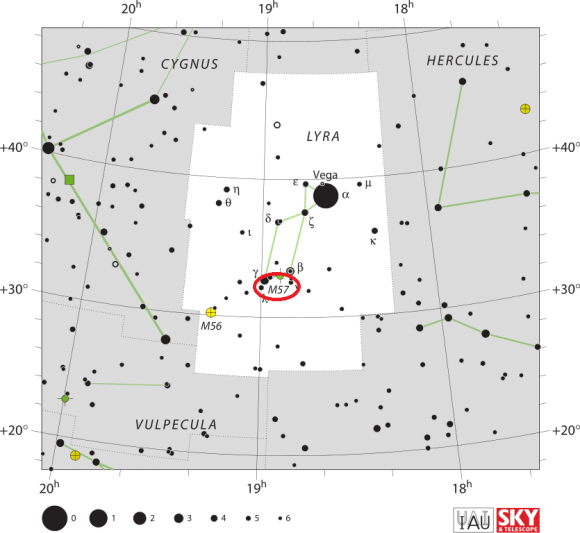
And here are the quick facts on Messier 57 to help you get started:
Object Name: Messier 57
Alternative Designations: M57, NGC 6720, the “Ring Nebula”
Object Type: Planetary Nebula
Constellation: Lyra
Right Ascension: 18 : 53.6 (h:m)
Declination: +33 : 02 (deg:m)
Distance: 2.3 (kly)
Visual Brightness: 8.8 (mag)
Apparent Dimension: 1.4×1.0 (arc min)
We have written many interesting articles about Messier Objects here at Universe Today. Here’s Tammy Plotner’s Introduction to the Messier Objects, M1 – The Crab Nebula, and David Dickison’s articles on the 2013 and 2014 Messier Marathons.
Be to sure to check out our complete Messier Catalog. And for more information, check out the SEDS Messier Database.
Sources:
Messier 27 – The Dumbbell Nebula

Welcome back to Messier Monday! In our ongoing tribute to the great Tammy Plotner, we take a look at the famous and easily-spotted Dumbbell Nebula. Enjoy!
Back in the 18th century, famed French astronomer Charles Messier noted the presence of several “nebulous objects” in the night sky. Having originally mistaken them for comets, he began compiling a list of them so that others would not make the same mistake he did. In time, this list would come to include 100 of the most fabulous objects in the night sky.
Known today as the Messier Catalog, this work has come to be viewed as one of the most important milestones in the study of Deep Space Objects. One of these is the famed Dumbbell Nebula – also known as Messier 27, the Apple Core Nebula, and NGC 6853. Because it of its brightness, it is easily viewed with binoculars and amateur telescopes, and was the first planetary Nebula to be discovered by Charles Messier.
Description:
This bright planetary nebula is located in the direction of the Vulpecula constellation, at a distance of about 1,360 light years from Earth. Located within the equatorial plane, this nebula is essentially a dying star that has been ejecting a shell of hot gas into space for roughly 48,000 years.
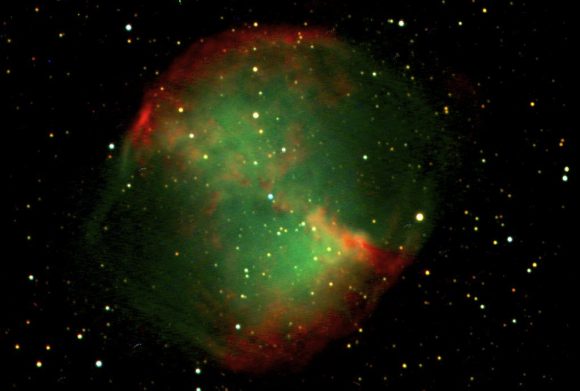
The star responsible is an extremely hot blueish subdwarf star, which emits primarily highly energetic radiation in the non-visible part of the electromagnetic spectrum. This energy is absorbed by exciting the nebula’s gas, and then re-emitted by the nebula. Messier 27 particular green glow (hence the nickname “Apple Core Nebula”) is due to the presence of doubly-ionized oxygen in its center, which emits green light at 5007 Angstroms.
For many years I quested to understand the distant and mysterious M27, but no one could answer my questions. I researched it, and learned that it was made up of doubly ionized oxygen. I had hoped that perhaps there was a spectral reason to what I viewed year after year – but still no answer.
Like all amateurs, I became the victim of “aperture fever” and I continued to study M27 with a 12″ telescope, never realizing the answer was right there – I just hadn’t powered up enough. Several years later while studying at the Observatory, I was viewing through a friend’s identical 12″ telescope and, as chance would have it, he was using about twice the magnification that I normally used on the “Dumbbell.”
Imagine my total astonishment as I realized for the very first time that the faint central star had an even fainter companion that made it seem to wink! At smaller apertures or low power, this was not revealed. Still, the eye could “see” a movement within the nebula – the central, radiating star and its companion.
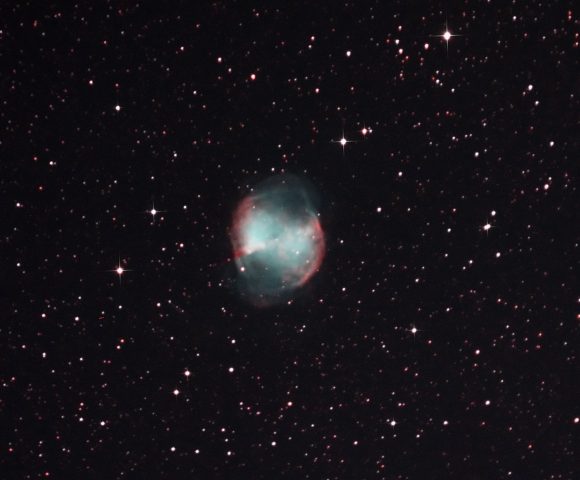
As W.G. Mathews of the University of California put it in his study “Dynamical Evolution of a Model Planetary Nebula”:
“As the gas at the inner edge begins to ionize, the pressure throughout the nebula is equalized by a shock which moves outward through the neutral gas. Later, when about 1/10 of the nebular mass is ionized, a second shock is released from the ionized front, and this shock moves through the neutral shell reaching the outer edge. The density of the HI gas just behind the shock is quite large and the outward gas velocity increases within until it reaches a maximum of 40-80 km per second just behind the shock front. The projected appearance of the nebula during this stage has a double ring structure similar to many observed planetaries.”
R.E. Lupu of John Hopkins has also made studies of motion as well, which they published in a study titled “Discovery of Lyman-alpha Pumped Molecular Hydrogen Emission in the Planetary Nebulae NGC 6853 and NGC 3132“. As they indicated, and found them to “have low surface brightness signatures in the visible and near infrared.”
But, movement or no movement, Messier 27 is known as one of the top “polluters” of the interstellar medium. As Joseph L. Hora ( et al.) of the Harvard-Smithsonian Center for Astrophysics said in his 2008 study “Planetary Nebulae: Exposing the Top Polluters of the ISM“:
“The high mass loss rates of stars in their asymptotic giant branch (AGB) stage of evolution is one of the most important pathways for mass return from stars to the ISM. In the planetary nebulae (PNe) phase, the ejected material is illuminated and can be altered by the UV radiation from the central star. PNe therefore play a significant role in the ISM recycling process and in changing the environment around them…
“A key link in the recycling of material to the Interstellar Medium (ISM) is the phase of stellar evolution from Asymptotic Giant Branch (AGB) to white dwarf star. When stars are on the AGB, they begin to lose mass at a prodigious rate. The stars on the AGB are relatively cool, and their atmospheres are a fertile environment for the formation of dust and molecules. The material can include molecular hydrogen (H2), silicates, and carbon-rich dust. The star is fouling its immediate neighborhood with these noxious emissions. The star is burning clean hydrogen fuel, but unlike a “green” hydrogen vehicle that outputs nothing except water, the star produces ejecta of various types, some of which have properties similar to that of soot from a gas-burning automobile. A significant fraction of the material returned to the ISM goes through the AGB – PNe pathway, making these stars one of the major sources of pollution of the ISM.
“However, these stars are not done with their stellar ejecta yet. Before the slow, massive AGB wind can escape, the star begins a rapid evolution where it contracts and its surface temperature increases. The star starts ejecting a less massive but high velocity wind that crashes into the existing circumstellar material, which can create a shock and a higher density shell. As the stellar temperature increases, the UV flux increases and it ionizes the gas surrounding the central star, and can excite emission from molecules, heat the dust, and even begin to break apart the molecules and dust grains. The objects are then visible as planetary nebulae, exposing their long history of spewing material into the ISM, and further processing the ejecta. There are even reports that the central stars of some PNe may be engaging in nucleosynthesis for purposes of self-enrichment, which can be traced by monitoring the elemental abundances in the nebulae. Clearly, we must assess and understand the processes going on in these objects in order to understand their impact on the ISM, and their influence on future generations of stars.”
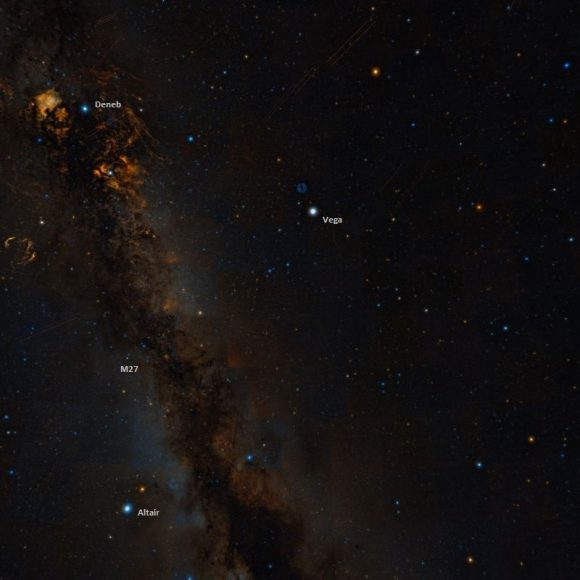
History of Observation:
So, chances are on July 12th, 1764, when Charles Messier discovered this new and fascinating class of objects, he didn’t really have a clue as to how important his observation would be. From his notes of that night, he reports:
“I have worked on the research of the nebulae, and I have discovered one in the constellation Vulpecula, between the two forepaws, and very near the star of fifth magnitude, the fourteenth of that constellation, according to the catalog of Flamsteed: One sees it well in an ordinary refractor of three feet and a half. I have examined it with a Gregorian telescope which magnified 104 times: it appears in an oval shape; it doesn’t contain any star; its diameter is about 4 minutes of arc. I have compared that nebula with the neighboring star which I have mentioned above [14 Vul]; its right ascension has been concluded at 297d 21′ 41″, and its declination 22d 4′ 0″ north.”
Of course, Sir William Herschel’s own curiosity would get the better of him and although he would never publish his own findings on an object previously cataloged by Messier, he did keep his own private notes. Here is an excerpt from just one of his many observations:
“1782, Sept. 30. My sister discovered this nebula this evening in sweeping for comets; on comparing its place with Messier’s nebulae we find it is his 27. It is very curious with a compound piece; the shape of it though oval as M. [Messier] calls it, is rather divided in two; it is situated among a number of small [faint] stars, but with this compound piece no star is visible in it. I can only make it bear 278. It vanishes with higher powers on account of its feeble light. With 278 the division between the two patches is stronger, because the intermediate faint light vanishes more.”
So where did Messier 27 get its famous moniker? From Sir John Herschel, who wrote: “A most extraordinary object; very bright; an unresolved nebula, shaped something like an hour-glass, filled into an oval outline with a much less dense nebulosity. The central mass may be compared to a vertebra or a dumb-bell. The southern head is denser than the northern. One or two stars seen in it.”
It would be several years, and several more historical astronomers, before the true nature of Messier 27 would even be hinted at. At one level, they understood it to be a nebula – but it wasn’t until 1864 when William Huggins came along and began to decode the mystery:
“It is obvious that the nebulae 37 H IV (NGC 3242), Struve 6 (NGC 6572), 73 H IV (NGC 6826), 1 H IV (NGC 7009), 57 M, 18 H. IV (NGC 7662) and 27 M. can no longer be regarded as aggregations of suns after the order to which our own sun and the fixed stars belong. We have with these objects to do no longer with a special modification only of our own type of suns, but find ourselves in the presence of objects possessing a distinct and peculiar plan of structure. In place of an incandescent solid or liquid body transmitting light of all refrangibilities through an atmosphere which intercepts by absorption a certain number of them, such as our sun appears to be, we must probably regard these objects, or at least their photo-surfaces, as enormous masses of luminous gas or vapour. For it is alone from matter in the gaseous state that light consisting of certain definite refrangibilities only, as is the case with the light of these nebulae, is known to be emitted.”
Whether or not you enjoy M27 as one of the most superb planetary nebula in the night sky (or as a science object) you will 100% agree with the words of of Burnham: “The observer who spends a few moments in quiet contemplation of this nebula will be made aware of direct contact with cosmic things; even the radiation reaching us from the celestial depths is of a type unknown on Earth…”
Locating Messier 27:
When you first begin, Messier 27 will seem like such an elusive target – but with a few simple sky “tricks”, it won’t be long until you’ll be finding this spectacular planetary nebula under just about any sky conditions. The hardest part is simply sorting out all the stars in the area to know the right ones to aim at!
The way I found easiest to teach others was to start BIG. The cruciform patterns of the Cygnus and Aquila constellations are easy to recognize and can be seen from even urban locations. Once you’ve identified these two constellations, you’re going smaller by locating Lyra and the tiny kite-shape of Delphinus.
Now you’ve circled the area and the hunt for Vulpecula the Fox begins! What’s that you say? You can’t distinguish Vulpecula’s primary stars from the rest of the field? You’re right. They don’t stand out like they should, and being tempted to simply aim halfway between Albeireo (Beta Cygni) and Alpha Delphini is too much of a span to be accurate. So what are we going to do? Here’s where some patience comes into play.
If you give yourself time, you’ll begin to notice the stars of Sagitta are ever so slightly brighter than the rest of the field stars around it, and it won’t be long until you pick out that arrow pattern. In your mind, measure the distance between Delta and Gamma (the 8 and Y shape on a starfinder map) and then just aim your binoculars or finderscope exactly that same distance due north of Gamma.
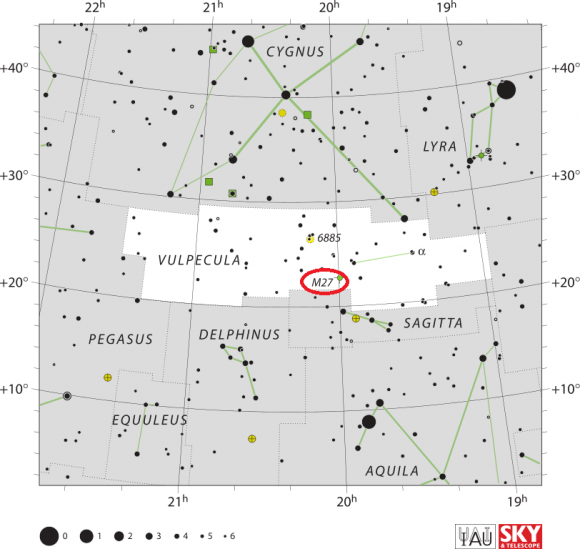
You’ll find M27 every time! In average binoculars it will appear as a fuzzy, out of focus large star in a stellar field. In the finderscope, it may not appear at all… But in a telescope? Be prepared to be blown away! And here are the quick facts on the Dumbbell Nebula to help get you started:
Object Name: Messier 27
Alternative Designations: M27, NGC 6853, The Dumbbell Nebula
Object Type: Planetary Nebula
Constellation: Vulpecula
Right Ascension: 19 : 59.6 (h:m)
Declination: +22 : 43 (deg:m)
Distance: 1.25 (kly)
Visual Brightness: 7.4 (mag)
Apparent Dimension: 8.0×5.7 (arc min)
We have written many interesting articles about Messier Objects here at Universe Today. Here’s Tammy Plotner’s Introduction to the Messier Objects, , M1 – The Crab Nebula, M8 – The Lagoon Nebula, and David Dickison’s articles on the 2013 and 2014 Messier Marathons.
Be to sure to check out our complete Messier Catalog. And for more information, check out the SEDS Messier Database.
Sources:
The Aquarius Constellation
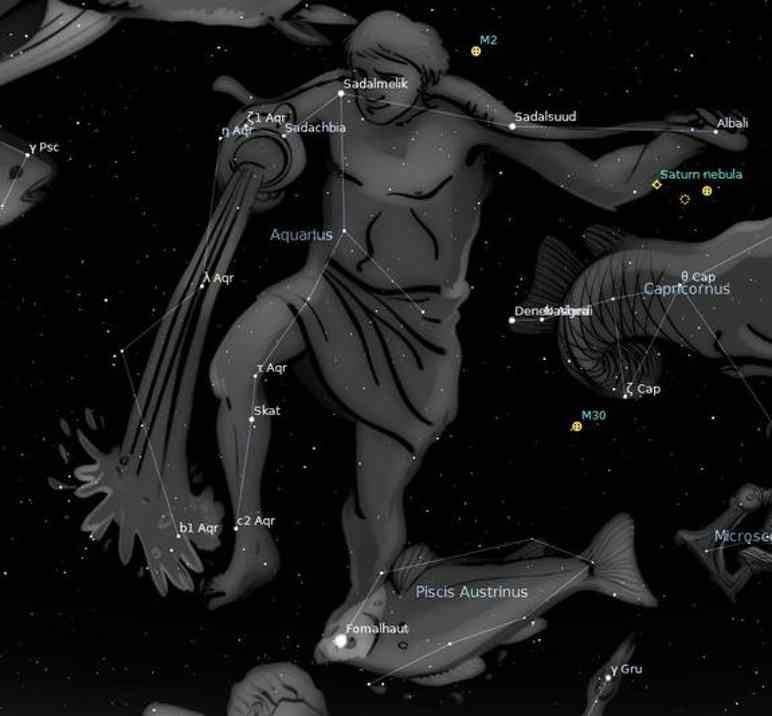
Welcome back to Constellation Friday! Today, we will be dealing with one of the best-known constellations, that “watery” asterism and section of the sky known as Aquarius. Cue the soundtrack from Hair!
In the 2nd century CE, Greek-Egyptian astronomer Claudius Ptolemaeus (aka. Ptolemy) compiled a list of all the-then known constellations. This work (known as the Almagest) would remain the definitive guide to astronomy and astrology for over a thousand years. Among the 48 constellations listed in this book was Aquarius, a constellation of the zodiac that stretches from the celestial equator to the southern hemisphere.
Also known as the “Water Carrier”, Aquarius is bordered by Pegasus, Equuleus and Delphinus at the north, Aquila to the west, Capricornus to the south-west, Piscis Austrinus and Sculptor to the south, Cetus to the east and Pisces to the north-east. Today, it is one of the 88 constellations recognized by the International Astronomical Union (IAU), and is perhaps the most referenced and recognized of all the constellation.
Continue reading “The Aquarius Constellation”
Why Do Red Giants Expand?
We know that the Sun will last another 5 billion years and then expand us a red giant. What will actually make this process happen?
One of the handy things about the Universe, apart from the fact that it exists, is that it lets us see crazy different configurations of everything, including planets, stars and galaxies.
We see stars like our Sun and dramatically unlike our Sun. Tiny, cool red dwarf stars with a fraction of the mass of our own, sipping away at their hydrogen juice boxes for billions and even trillions of years. Stars with way more mass than our own, blasting out enormous amounts of radiation, only lasting a few million years before they detonate as supernovae.
There are ones younger than the Sun; just now clearing out the gas and dust in their solar nebula with intense ultraviolet radiation. Stars much older than ours, bloated up into enormous sizes, nearing the end of their lives before they fade into their golden years as white dwarfs.
The Sun is a main sequence star, converting hydrogen into helium at its core, like it’s been doing for more than 4.5 billion years, and will continue to do so for another 5 or so. At the end of its life, it’s going to bloat up as a red giant, so large that it consumes Mercury and Venus, and maybe even Earth.
What’s the process going on inside the Sun that makes this happen? Let’s peel away the Sun and take a look at the core. After we’re done screaming about the burning burning hands, we’ll see that the Sun is this enormous sphere of hydrogen and helium, 1.4 million kilometers across, the actual business of fusion is happening down in the core, a region that’s a delicious bubblegum center a tiny 280,000 kilometers across.
The core is less than one percent of the entire volume, but because the density of hydrogen in the chewy center is 150 times more than liquid water, it accounts for a freakishly huge 35% of its mass.
It’s thanks to the mass of the entire star, 2 x 10^30 kg, bearing down on the core thanks to gravity. Down here in the core, temperatures are more than 15 million degrees Celsius. It’s the perfect spot for nuclear fusion picnic.
There are a few paths fusion can take, but the main one is where hydrogen atoms are mushed into helium. This process releases enough gamma radiation to make you a planet full of Hulks.
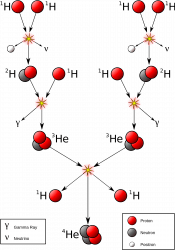
While the Sun has been performing hydrogen fusion, all this helium has been piling up at its core, like nuclear waste. Terrifyingly, it’s still fuel, but our little Sun just doesn’t have the temperature or pressure at its core to be able to use it.
Eventually, the fusion at the core of the Sun shuts down, choked off by all this helium and in a last gasp of high pitched mickey mouse voice terror the helium core begins to contract and heat up. At this point, an amazing thing happens. It’s now hot enough for a layer of hydrogen just around the core to heat up and begin fusion again. The Sun now gets a second chance at life.
As this outer layer contains a bigger volume than the original core of the Sun, it heats up significantly, releasing far more energy. This increase in light pressure from the core pushes much harder against gravity, and expands the volume of the Sun.
Even this isn’t the end of the star’s life. Dammit, Harkness, just stay down. Helium continues to build up, and even this extra shell around the core isn’t hot and dense enough to support fusion. So the core dies again. The star begins to contract, the gravitational energy heats up again, allowing another shell of hydrogen to have the pressure and temperature for fusion, and then we’re back in business!
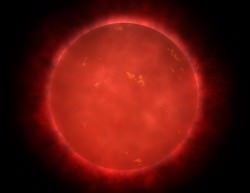
Our Sun will likely go through this process multiple times, each phase taking a few years to complete as it expands and contracts, heats and cools. Our Sun becomes a variable star.
Eventually, we run out of usable hydrogen, but fortunately, it’s able to switch over to using helium as fuel, generating carbon and oxygen as byproducts. This doesn’t last long, and when it’s gone, the Sun gets swollen to hundreds of times its size, releasing thousands of times more energy.
This is when the Sun becomes that familiar red giant, gobbling up the tasty planets, including, quite possibly the Earth.The remaining atmosphere puffs out from the Sun, and drifts off into space creating a beautiful planetary nebula that future alien astronomers will enjoy for thousands of years. What’s left is a carbon oxygen core, a white dwarf.
The Sun is completely out of tricks to make fusion happen any more, and it’ll now cool down to the background temperature of the Universe. Our Sun will die in a dramatic way, billions of years from now when it bloats up 500 times its original volume.
What do you think future alien astronomers will call the planetary nebula left behind by the Sun? Give it a name in the comments below.
Two Stars On A Death Spiral Set To Detonate As A Supernova
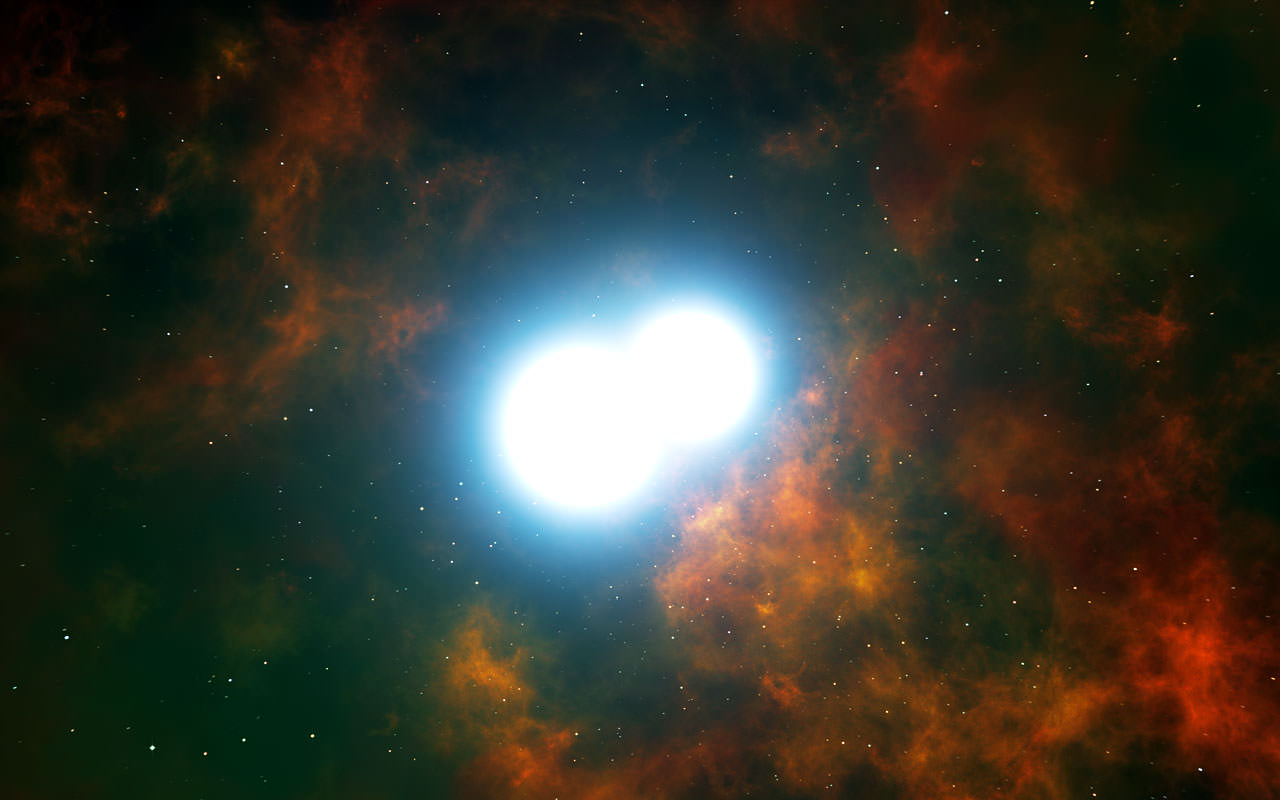
Two white dwarfs circle around one other, locked in a fatal tango. With an intimate orbit and a hefty combined mass, the pair is ultimately destined to collide, merge, and erupt in a titanic explosion: a Type Ia supernova.
Or so goes the theory behind the infamous “standard candles” of cosmology.
Now, in a paper published in today’s issue of Nature, a team of astronomers have announced observational support for such an arrangement – two massive white dwarf stars that appear to be on track for a very explosive demise.
The astronomers were originally studying variations in planetary nebulae, the glowing clouds of gas that red giant stars throw off as they fizzle into white dwarfs. One of their targets was the planetary nebula Henize 2-428, an oddly lopsided specimen that, the team believed, owed its shape to the existence of two central stars, rather than one. After observing the nebula with the ESO’s Very Large Telescope, the astronomers concluded that they were correct – Henize 2-428 did, in fact, have a binary star system at its heart.
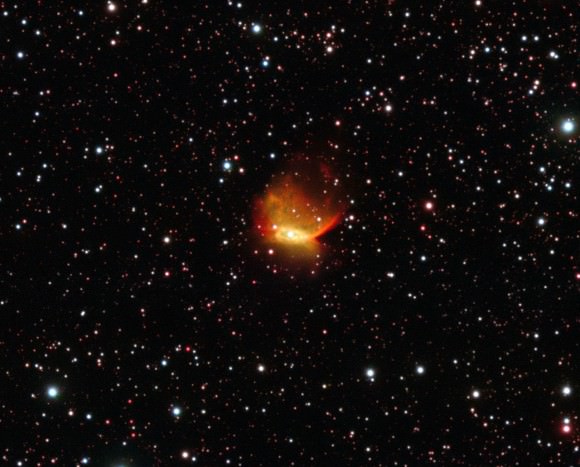
“Further observations made with telescopes in the Canary Islands allowed us to determine the orbit of the two stars and deduce both the masses of the two stars and their separation,” said Romano Corradi, a member of the team.
And that is where things get juicy.
In fact, the two stars are whipping around each other once every 4.2 hours, implying a narrow separation that is shrinking with each orbit. Moreover, the system has a combined heft of 1.76 solar masses – larger, by any count, than the restrictive Chandrasekhar limit, the maximum ~1.4 solar masses that a white dwarf can withstand before it detonates. Based on the team’s calculations, Henize 2-428 is likely to be the site of a type Ia supernova within the next 700 million years.
“Until now, the formation of supernovae Type Ia by the merging of two white dwarfs was purely theoretical,” explained David Jones, another of the paper’s coauthors. “The pair of stars in Henize 2-428 is the real thing!”
Check out this simulation, courtesy of the ESO, for a closer look at the fate of the dynamic duo:
Astronomers should be able to use the stars of Henize 2-428 to test and refine their models of type Ia supernovae – essential tools that, as lead author Miguel Santander-García emphasized, “are widely used to measure astronomical distances and were key to the discovery that the expansion of the Universe is accelerating due to dark energy.” This system may also enhance scientists’ understanding of the precursors of other irregular planetary nebulae and supernova remnants.
The team’s work was published in the February 9 issue of Nature. A copy of the paper is available here.
Behold: 100 Planetary Nebulas
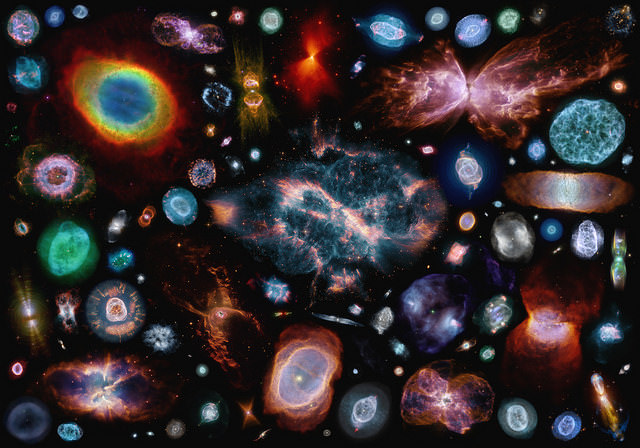
If you like planetary nebulas, you’re in luck. Multimedia artist Judy Schmidt has put together an amazing collection of 100 of these colorful glowing shells of gas and plasma, all at apparent size relative to one another. There’s even a giant-sized 10,000 pixel-wide version available on Flickr.
How many of these planetary nebulae can you identify?
Judy explained her inspiration for putting together this wonderful ‘poster’:
Inspired by insect illustration posters, this is a large collage of planetary nebulas I put together bit by bit as I processed them. All are presented north up and at apparent size relative to one another–I did not rotate or resize them in order to satisfy compositional aesthetics (if you spot any errors, let me know). Colors are aesthetic choices, especially since most planetary nebulas are imaged with narrowband filters.
Planetary nebulae are formed by certain types of stars at the end of their lives, and actually have nothing to do with planets. They were given the confusing name 300 years ago by William Herschel because in early, rudimentary telescopes, the puffed out balls of gas looked like planets.
Our own Sun will likely undergo a similar process, but not for another 5 billion years or so.
You can see more of Judy’s work at her website “Geckzilla” or Flickr page.

